

Compact Muon Solenoid
LHC, CERN
| CMS-PAS-GEN-17-001 | ||
| Extraction and validation of a new set of CMS PYTHIA 8 tunes from underlying-event measurements | ||
| CMS Collaboration | ||
| August 2018 | ||
| Abstract: A new set of CMS underlying-event tunes is presented for the PYTHIA8 event generator. The tunes use the NNPDF3.1 parton distribution functions at leading (LO), next-to-leading (NLO), or next-to-next-to-leading (NNLO) order in perturbative quantum chromodynamics, and the strong coupling evolution at LO or NLO. Measurements of charged-particle multiplicity and transverse momentum densities at various hadron collision energies are simultaneously fitted to determine the parameters of the tunes. Comparisons of the predictions of the new tunes are provided for observables sensitive to the global underlying event, to soft multiparton interactions, and to double-parton scattering contributions, as well as for observables measured in various final states, such as multijet, Drell-Yan, and top quark-antiquark pair production. Here the simulation of the underlying event provided by the new tunes is interfaced to a higher-order matrix-element calculation. For the first time, it is shown that predictions obtained with tunes based on NLO or NNLO parton distribution function (PDF) sets can reliably describe minimum-bias and underlying-event data, with a similar level of agreement as predictions from tunes using LO PDF sets. | ||
|
Links:
CDS record (PDF) ;
CADI line (restricted) ;
These preliminary results are superseded in this paper, EPJC 80 (2020) 4. The superseded preliminary plots can be found here. |
||
| Figures | |

png pdf |
Figure 1:
Illustration of the regions of $\eta $-$\phi $ space that are defined relative to the direction of a leading object in the event. See text for the definitions of the regions. |

png pdf |
Figure 2:
CMS data [12] at $\sqrt{s} = $ 13 TeV on the (a,c) transMIN and (b,d) transMAX charged-particle $p_{\rm T}^{\rm sum}$ (a,b) and multiplicity (c,d) densities, for particles with $ {p_{\mathrm {T}}} > $ 0.5 GeV in $|\eta |$ < 2.0, as a function of the transverse momentum of the leading charged-particle ($p_{\rm T}^{\rm max}$). The data are compared to the PYTHIA 8 tune Monash, the CMS PYTHIA 8 tunes CUETP8S1-CTEQ6L1 and CUETP8M1, and the HERWIG 7 tune UE-MMHT. The ratios of the theory and the data (MC/data) are also shown, where the shaded band indicates the total experimental uncertainty of the data. |

png pdf |
Figure 2-a:
CMS data [12] at $\sqrt{s} = $ 13 TeV on the transMIN charged-particle $p_{\rm T}^{\rm sum}$ density, for particles with $ {p_{\mathrm {T}}} > $ 0.5 GeV in $|\eta |$ < 2.0, as a function of the transverse momentum of the leading charged-particle ($p_{\rm T}^{\rm max}$). The data are compared to the PYTHIA 8 tune Monash, the CMS PYTHIA 8 tunes CUETP8S1-CTEQ6L1 and CUETP8M1, and the HERWIG 7 tune UE-MMHT. The ratios of the theory and the data (MC/data) are also shown, where the shaded band indicates the total experimental uncertainty of the data. |
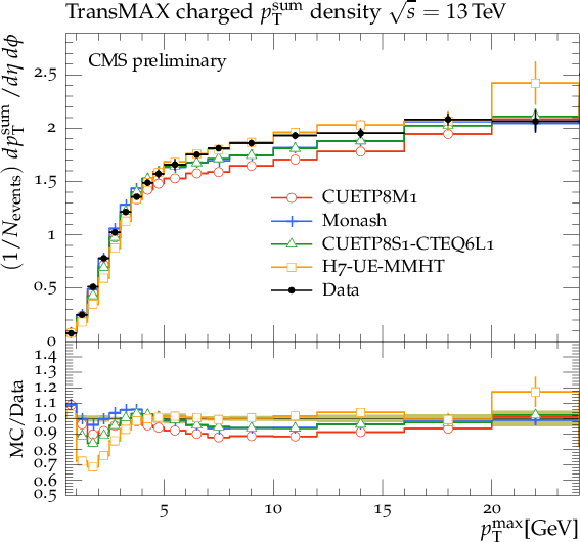
png pdf |
Figure 2-b:
CMS data [12] at $\sqrt{s} = $ 13 TeV on the transMAX charged-particle $p_{\rm T}^{\rm sum}$ density, for particles with $ {p_{\mathrm {T}}} > $ 0.5 GeV in $|\eta |$ < 2.0, as a function of the transverse momentum of the leading charged-particle ($p_{\rm T}^{\rm max}$). The data are compared to the PYTHIA 8 tune Monash, the CMS PYTHIA 8 tunes CUETP8S1-CTEQ6L1 and CUETP8M1, and the HERWIG 7 tune UE-MMHT. The ratios of the theory and the data (MC/data) are also shown, where the shaded band indicates the total experimental uncertainty of the data. |

png pdf |
Figure 2-c:
CMS data [12] at $\sqrt{s} = $ 13 TeV on the transMIN charged-particle multiplicity density, for particles with $ {p_{\mathrm {T}}} > $ 0.5 GeV in $|\eta |$ < 2.0, as a function of the transverse momentum of the leading charged-particle ($p_{\rm T}^{\rm max}$). The data are compared to the PYTHIA 8 tune Monash, the CMS PYTHIA 8 tunes CUETP8S1-CTEQ6L1 and CUETP8M1, and the HERWIG 7 tune UE-MMHT. The ratios of the theory and the data (MC/data) are also shown, where the shaded band indicates the total experimental uncertainty of the data. |

png pdf |
Figure 2-d:
CMS data [12] at $\sqrt{s} = $ 13 TeV on the transMAX charged-particle multiplicity density, for particles with $ {p_{\mathrm {T}}} > $ 0.5 GeV in $|\eta |$ < 2.0, as a function of the transverse momentum of the leading charged-particle ($p_{\rm T}^{\rm max}$). The data are compared to the PYTHIA 8 tune Monash, the CMS PYTHIA 8 tunes CUETP8S1-CTEQ6L1 and CUETP8M1, and the HERWIG 7 tune UE-MMHT. The ratios of the theory and the data (MC/data) are also shown, where the shaded band indicates the total experimental uncertainty of the data. |

png pdf |
Figure 3:
CMS data at $\sqrt{s} = $ 13 TeV [12] on the transMIN (a) charged-particle and (b) charged $p_{\rm T}^{\rm sum}$ densities; and the transMAX (c) charged-particle and (d) charged $p_{\rm T}^{\rm sum}$ densities, as defined by the leading charged particle, as a function of the transverse momentum of the leading charged particle, $ {p_{\mathrm {T}}} ^{\rm max}$. Charged hadrons are measured with $ {p_{\mathrm {T}}} > $ 0.5 GeV in $|\eta | < $ 2.0. The data are compared with the CMS PYTHIA 8 LO-PDF tunes CP1 and CP2. The ratios of the theory and the data (MC/data) are also shown, where the shaded band indicates the total experimental uncertainty of the data. |

png pdf |
Figure 3-a:
CMS data at $\sqrt{s} = $ 13 TeV [12] on the transMIN charged-particle density, as defined by the leading charged particle, as a function of the transverse momentum of the leading charged particle, $ {p_{\mathrm {T}}} ^{\rm max}$. Charged hadrons are measured with $ {p_{\mathrm {T}}} > $ 0.5 GeV in $|\eta | < $ 2.0. The data are compared with the CMS PYTHIA 8 LO-PDF tunes CP1 and CP2. The ratios of the theory and the data (MC/data) are also shown, where the shaded band indicates the total experimental uncertainty of the data. |

png pdf |
Figure 3-b:
CMS data at $\sqrt{s} = $ 13 TeV [12] on the transMIN charged $p_{\rm T}^{\rm sum}$ density, as defined by the leading charged particle, as a function of the transverse momentum of the leading charged particle, $ {p_{\mathrm {T}}} ^{\rm max}$. Charged hadrons are measured with $ {p_{\mathrm {T}}} > $ 0.5 GeV in $|\eta | < $ 2.0. The data are compared with the CMS PYTHIA 8 LO-PDF tunes CP1 and CP2. The ratios of the theory and the data (MC/data) are also shown, where the shaded band indicates the total experimental uncertainty of the data. |

png pdf |
Figure 3-c:
CMS data at $\sqrt{s} = $ 13 TeV [12] on the transMIN transMAX charged-particle density, as defined by the leading charged particle, as a function of the transverse momentum of the leading charged particle, $ {p_{\mathrm {T}}} ^{\rm max}$. Charged hadrons are measured with $ {p_{\mathrm {T}}} > $ 0.5 GeV in $|\eta | < $ 2.0. The data are compared with the CMS PYTHIA 8 LO-PDF tunes CP1 and CP2. The ratios of the theory and the data (MC/data) are also shown, where the shaded band indicates the total experimental uncertainty of the data. |

png pdf |
Figure 3-d:
CMS data at $\sqrt{s} = $ 13 TeV [12] on the transMIN transMAX charged $p_{\rm T}^{\rm sum}$ density, as defined by the leading charged particle, as a function of the transverse momentum of the leading charged particle, $ {p_{\mathrm {T}}} ^{\rm max}$. Charged hadrons are measured with $ {p_{\mathrm {T}}} > $ 0.5 GeV in $|\eta | < $ 2.0. The data are compared with the CMS PYTHIA 8 LO-PDF tunes CP1 and CP2. The ratios of the theory and the data (MC/data) are also shown, where the shaded band indicates the total experimental uncertainty of the data. |

png pdf |
Figure 4:
CMS data at $\sqrt{s} = $ 13 TeV [12] on the transMIN (a) charged-particle and (b) charged $p_{\rm T}^{\rm sum}$ densities; and the transMAX (c) charged-particle and (d) charged $p_{\rm T}^{\rm sum}$ densities, as defined by the leading charged particle, as a function of the transverse momentum of the leading charged particle, $ {p_{\mathrm {T}}} ^{\rm max}$. Charged hadrons are measured with $ {p_{\mathrm {T}}} > $ 0.5 GeV in $|\eta | < $ 2.0. The data are compared with the CMS PYTHIA 8 (N)NLO-PDF tunes CP3, CP4, and CP5. The ratios of the theory and the data (MC/data) are also shown, where the shaded band indicates the total experimental uncertainty of the data. |
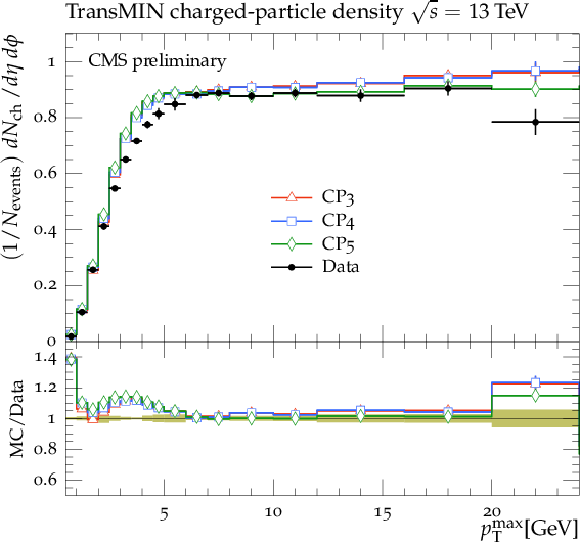
png pdf |
Figure 4-a:
CMS data at $\sqrt{s} = $ 13 TeV [12] on the transMIN charged-particle density, as defined by the leading charged particle, as a function of the transverse momentum of the leading charged particle, $ {p_{\mathrm {T}}} ^{\rm max}$. Charged hadrons are measured with $ {p_{\mathrm {T}}} > $ 0.5 GeV in $|\eta | < $ 2.0. The data are compared with the CMS PYTHIA 8 (N)NLO-PDF tunes CP3, CP4, and CP5. The ratios of the theory and the data (MC/data) are also shown, where the shaded band indicates the total experimental uncertainty of the data. |

png pdf |
Figure 4-b:
CMS data at $\sqrt{s} = $ 13 TeV [12] on the transMIN charged $p_{\rm T}^{\rm sum}$ density, as defined by the leading charged particle, as a function of the transverse momentum of the leading charged particle, $ {p_{\mathrm {T}}} ^{\rm max}$. Charged hadrons are measured with $ {p_{\mathrm {T}}} > $ 0.5 GeV in $|\eta | < $ 2.0. The data are compared with the CMS PYTHIA 8 (N)NLO-PDF tunes CP3, CP4, and CP5. The ratios of the theory and the data (MC/data) are also shown, where the shaded band indicates the total experimental uncertainty of the data. |

png pdf |
Figure 4-c:
CMS data at $\sqrt{s} = $ 13 TeV [12] on the transMAX charged-particle density, as defined by the leading charged particle, as a function of the transverse momentum of the leading charged particle, $ {p_{\mathrm {T}}} ^{\rm max}$. Charged hadrons are measured with $ {p_{\mathrm {T}}} > $ 0.5 GeV in $|\eta | < $ 2.0. The data are compared with the CMS PYTHIA 8 (N)NLO-PDF tunes CP3, CP4, and CP5. The ratios of the theory and the data (MC/data) are also shown, where the shaded band indicates the total experimental uncertainty of the data. |
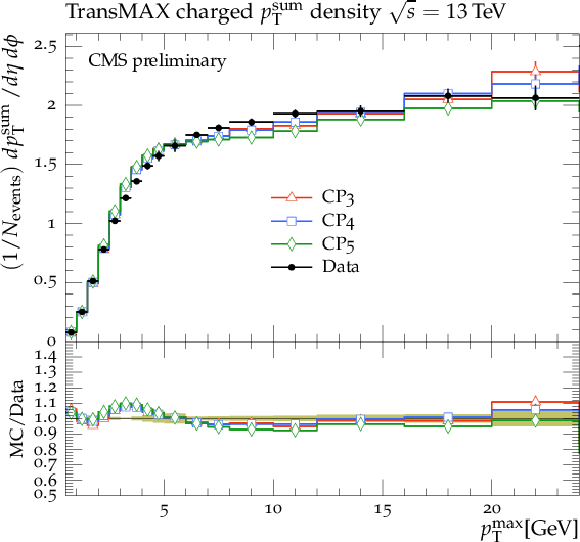
png pdf |
Figure 4-d:
CMS data at $\sqrt{s} = $ 13 TeV [12] on the transMAX charged $p_{\rm T}^{\rm sum}$ density, as defined by the leading charged particle, as a function of the transverse momentum of the leading charged particle, $ {p_{\mathrm {T}}} ^{\rm max}$. Charged hadrons are measured with $ {p_{\mathrm {T}}} > $ 0.5 GeV in $|\eta | < $ 2.0. The data are compared with the CMS PYTHIA 8 (N)NLO-PDF tunes CP3, CP4, and CP5. The ratios of the theory and the data (MC/data) are also shown, where the shaded band indicates the total experimental uncertainty of the data. |

png pdf |
Figure 5:
CMS data at $\sqrt{s} = $ 7 TeV [9] on the transMIN (a) charged-particle and (b) charged $p_{\rm T}^{\rm sum}$ densities; and the transMAX (c) charged-particle and (d) charged $p_{\rm T}^{\rm sum}$ densities, as defined by the leading charged particle, as a function of the transverse momentum of the leading charged particle, $ {p_{\mathrm {T}}} ^{\rm max}$. Charged hadrons are measured with $ {p_{\mathrm {T}}} > $ 0.5 GeV in $|\eta | < $ 0.8. The data are compared with the CMS PYTHIA 8 LO-PDF tunes CP1 and CP2. The ratios of the theory and the data (MC/data) are also shown, where the shaded band indicates the total experimental uncertainty of the data. |

png pdf |
Figure 5-a:
CMS data at $\sqrt{s} = $ 7 TeV [9] on the transMIN charged-particle density, as defined by the leading charged particle, as a function of the transverse momentum of the leading charged particle, $ {p_{\mathrm {T}}} ^{\rm max}$. Charged hadrons are measured with $ {p_{\mathrm {T}}} > $ 0.5 GeV in $|\eta | < $ 0.8. The data are compared with the CMS PYTHIA 8 LO-PDF tunes CP1 and CP2. The ratios of the theory and the data (MC/data) are also shown, where the shaded band indicates the total experimental uncertainty of the data. |

png pdf |
Figure 5-b:
CMS data at $\sqrt{s} = $ 7 TeV [9] on the transMIN charged $p_{\rm T}^{\rm sum}$ density, as defined by the leading charged particle, as a function of the transverse momentum of the leading charged particle, $ {p_{\mathrm {T}}} ^{\rm max}$. Charged hadrons are measured with $ {p_{\mathrm {T}}} > $ 0.5 GeV in $|\eta | < $ 0.8. The data are compared with the CMS PYTHIA 8 LO-PDF tunes CP1 and CP2. The ratios of the theory and the data (MC/data) are also shown, where the shaded band indicates the total experimental uncertainty of the data. |

png pdf |
Figure 5-c:
CMS data at $\sqrt{s} = $ 7 TeV [9] on the transMAX charged-particle density, as defined by the leading charged particle, as a function of the transverse momentum of the leading charged particle, $ {p_{\mathrm {T}}} ^{\rm max}$. Charged hadrons are measured with $ {p_{\mathrm {T}}} > $ 0.5 GeV in $|\eta | < $ 0.8. The data are compared with the CMS PYTHIA 8 LO-PDF tunes CP1 and CP2. The ratios of the theory and the data (MC/data) are also shown, where the shaded band indicates the total experimental uncertainty of the data. |

png pdf |
Figure 5-d:
CMS data at $\sqrt{s} = $ 7 TeV [9] on the transMAX charged $p_{\rm T}^{\rm sum}$ density, as defined by the leading charged particle, as a function of the transverse momentum of the leading charged particle, $ {p_{\mathrm {T}}} ^{\rm max}$. Charged hadrons are measured with $ {p_{\mathrm {T}}} > $ 0.5 GeV in $|\eta | < $ 0.8. The data are compared with the CMS PYTHIA 8 LO-PDF tunes CP1 and CP2. The ratios of the theory and the data (MC/data) are also shown, where the shaded band indicates the total experimental uncertainty of the data. |

png pdf |
Figure 6:
CMS data at $\sqrt{s} = $ 7 TeV [9] on the transMIN (a) charged-particle and (b) charged $p_{\rm T}^{\rm sum}$ densities; and the transMAX (c) charged-particle and (d) charged $p_{\rm T}^{\rm sum}$ densities, as defined by the leading charged particle, as a function of the transverse momentum of the leading charged particle, $ {p_{\mathrm {T}}} ^{\rm max}$. Charged hadrons are measured with $ {p_{\mathrm {T}}} > $ 0.5 GeV in $|\eta | < $ 0.8. The data are compared with the CMS PYTHIA 8 (N)NLO-PDF tunes CP3, CP4, and CP5. The ratios of the theory and the data (MC/data) are also shown, where the shaded band indicates the total experimental uncertainty of the data. |
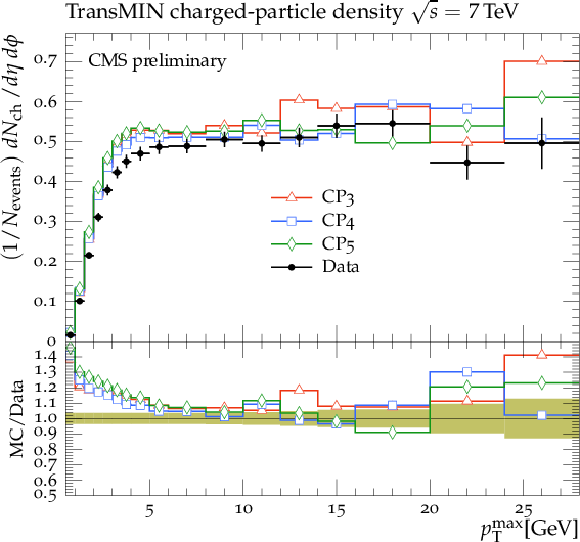
png pdf |
Figure 6-a:
CMS data at $\sqrt{s} = $ 7 TeV [9] on the transMIN charged-particle density, as defined by the leading charged particle, as a function of the transverse momentum of the leading charged particle, $ {p_{\mathrm {T}}} ^{\rm max}$. Charged hadrons are measured with $ {p_{\mathrm {T}}} > $ 0.5 GeV in $|\eta | < $ 0.8. The data are compared with the CMS PYTHIA 8 (N)NLO-PDF tunes CP3, CP4, and CP5. The ratios of the theory and the data (MC/data) are also shown, where the shaded band indicates the total experimental uncertainty of the data. |
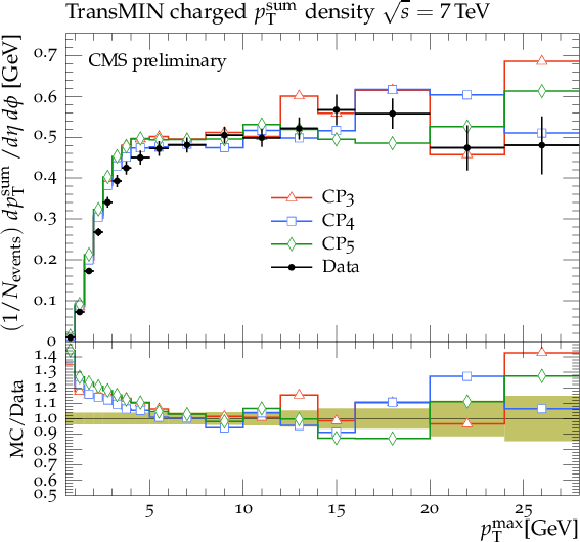
png pdf |
Figure 6-b:
CMS data at $\sqrt{s} = $ 7 TeV [9] on the transMIN charged $p_{\rm T}^{\rm sum}$ density, as defined by the leading charged particle, as a function of the transverse momentum of the leading charged particle, $ {p_{\mathrm {T}}} ^{\rm max}$. Charged hadrons are measured with $ {p_{\mathrm {T}}} > $ 0.5 GeV in $|\eta | < $ 0.8. The data are compared with the CMS PYTHIA 8 (N)NLO-PDF tunes CP3, CP4, and CP5. The ratios of the theory and the data (MC/data) are also shown, where the shaded band indicates the total experimental uncertainty of the data. |

png pdf |
Figure 6-c:
CMS data at $\sqrt{s} = $ 7 TeV [9] on the transMAX charged-particle density, as defined by the leading charged particle, as a function of the transverse momentum of the leading charged particle, $ {p_{\mathrm {T}}} ^{\rm max}$. Charged hadrons are measured with $ {p_{\mathrm {T}}} > $ 0.5 GeV in $|\eta | < $ 0.8. The data are compared with the CMS PYTHIA 8 (N)NLO-PDF tunes CP3, CP4, and CP5. The ratios of the theory and the data (MC/data) are also shown, where the shaded band indicates the total experimental uncertainty of the data. |

png pdf |
Figure 6-d:
CMS data at $\sqrt{s} = $ 7 TeV [9] on the transMAX charged $p_{\rm T}^{\rm sum}$ density, as defined by the leading charged particle, as a function of the transverse momentum of the leading charged particle, $ {p_{\mathrm {T}}} ^{\rm max}$. Charged hadrons are measured with $ {p_{\mathrm {T}}} > $ 0.5 GeV in $|\eta | < $ 0.8. The data are compared with the CMS PYTHIA 8 (N)NLO-PDF tunes CP3, CP4, and CP5. The ratios of the theory and the data (MC/data) are also shown, where the shaded band indicates the total experimental uncertainty of the data. |
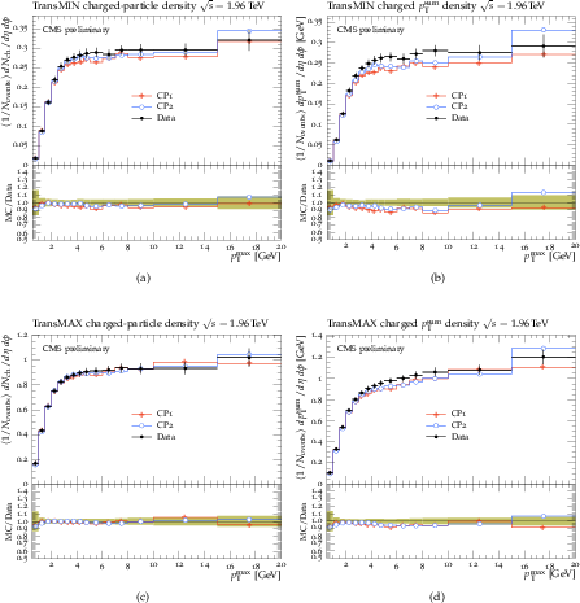
png pdf |
Figure 7:
CDF data at $\sqrt{s} = $ 1.96 TeV [8] on the transMIN (a) charged-particle and (b) charged $p_{\rm T}^{\rm sum}$ densities; and the transMAX (c) charged-particle and (d) charged $p_{\rm T}^{\rm sum}$ densities, as defined by the leading charged particle, as a function of the transverse momentum of the leading charged particle, $ {p_{\mathrm {T}}} ^{\rm max}$. Charged hadrons are measured with $ {p_{\mathrm {T}}} > $ 0.5 GeV in $|\eta | < $ 0.8. The data are compared with the CMS PYTHIA 8 LO-PDF tunes CP1 and CP2. The ratios of the theory and the data (MC/data) are also shown, where the shaded band indicates the total experimental uncertainty of the data. |

png pdf |
Figure 7-a:
CDF data at $\sqrt{s} = $ 1.96 TeV [8] on the transMIN charged-particle density, as defined by the leading charged particle, as a function of the transverse momentum of the leading charged particle, $ {p_{\mathrm {T}}} ^{\rm max}$. Charged hadrons are measured with $ {p_{\mathrm {T}}} > $ 0.5 GeV in $|\eta | < $ 0.8. The data are compared with the CMS PYTHIA 8 LO-PDF tunes CP1 and CP2. The ratios of the theory and the data (MC/data) are also shown, where the shaded band indicates the total experimental uncertainty of the data. |

png pdf |
Figure 7-b:
CDF data at $\sqrt{s} = $ 1.96 TeV [8] on the transMIN charged $p_{\rm T}^{\rm sum}$ density, as defined by the leading charged particle, as a function of the transverse momentum of the leading charged particle, $ {p_{\mathrm {T}}} ^{\rm max}$. Charged hadrons are measured with $ {p_{\mathrm {T}}} > $ 0.5 GeV in $|\eta | < $ 0.8. The data are compared with the CMS PYTHIA 8 LO-PDF tunes CP1 and CP2. The ratios of the theory and the data (MC/data) are also shown, where the shaded band indicates the total experimental uncertainty of the data. |

png pdf |
Figure 7-c:
CDF data at $\sqrt{s} = $ 1.96 TeV [8] on the transMAX charged-particle density, as defined by the leading charged particle, as a function of the transverse momentum of the leading charged particle, $ {p_{\mathrm {T}}} ^{\rm max}$. Charged hadrons are measured with $ {p_{\mathrm {T}}} > $ 0.5 GeV in $|\eta | < $ 0.8. The data are compared with the CMS PYTHIA 8 LO-PDF tunes CP1 and CP2. The ratios of the theory and the data (MC/data) are also shown, where the shaded band indicates the total experimental uncertainty of the data. |

png pdf |
Figure 7-d:
CDF data at $\sqrt{s} = $ 1.96 TeV [8] on the transMAX charged $p_{\rm T}^{\rm sum}$ density, as defined by the leading charged particle, as a function of the transverse momentum of the leading charged particle, $ {p_{\mathrm {T}}} ^{\rm max}$. Charged hadrons are measured with $ {p_{\mathrm {T}}} > $ 0.5 GeV in $|\eta | < $ 0.8. The data are compared with the CMS PYTHIA 8 LO-PDF tunes CP1 and CP2. The ratios of the theory and the data (MC/data) are also shown, where the shaded band indicates the total experimental uncertainty of the data. |

png pdf |
Figure 8:
CDF data at $\sqrt{s} = $ 1.96 TeV [8] on the transMIN (a) charged-particle and (b) charged $p_{\rm T}^{\rm sum}$ densities; and the transMAX (c) charged-particle and (d) charged $p_{\rm T}^{\rm sum}$ densities, as defined by the leading charged particle, as a function of the transverse momentum of the leading charged particle, $ {p_{\mathrm {T}}} ^{\rm max}$. Charged hadrons are measured with $ {p_{\mathrm {T}}} > $ 0.5 GeV in $|\eta | < $ 0.8. The data are compared with the CMS PYTHIA 8 (N)NLO-PDF tunes CP3, CP4, and CP5. The ratios of the theory and the data (MC/data) are also shown, where the shaded band indicates the total experimental uncertainty of the data. |

png pdf |
Figure 8-a:
CDF data at $\sqrt{s} = $ 1.96 TeV [8] on the transMIN charged-particle density, as defined by the leading charged particle, as a function of the transverse momentum of the leading charged particle, $ {p_{\mathrm {T}}} ^{\rm max}$. Charged hadrons are measured with $ {p_{\mathrm {T}}} > $ 0.5 GeV in $|\eta | < $ 0.8. The data are compared with the CMS PYTHIA 8 (N)NLO-PDF tunes CP3, CP4, and CP5. The ratios of the theory and the data (MC/data) are also shown, where the shaded band indicates the total experimental uncertainty of the data. |

png pdf |
Figure 8-b:
CDF data at $\sqrt{s} = $ 1.96 TeV [8] on the transMIN charged $p_{\rm T}^{\rm sum}$ density, as defined by the leading charged particle, as a function of the transverse momentum of the leading charged particle, $ {p_{\mathrm {T}}} ^{\rm max}$. Charged hadrons are measured with $ {p_{\mathrm {T}}} > $ 0.5 GeV in $|\eta | < $ 0.8. The data are compared with the CMS PYTHIA 8 (N)NLO-PDF tunes CP3, CP4, and CP5. The ratios of the theory and the data (MC/data) are also shown, where the shaded band indicates the total experimental uncertainty of the data. |
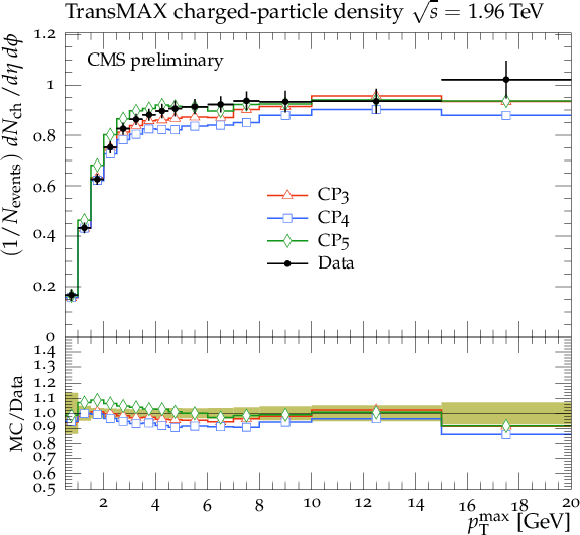
png pdf |
Figure 8-c:
CDF data at $\sqrt{s} = $ 1.96 TeV [8] on the transMAX charged-particle density, as defined by the leading charged particle, as a function of the transverse momentum of the leading charged particle, $ {p_{\mathrm {T}}} ^{\rm max}$. Charged hadrons are measured with $ {p_{\mathrm {T}}} > $ 0.5 GeV in $|\eta | < $ 0.8. The data are compared with the CMS PYTHIA 8 (N)NLO-PDF tunes CP3, CP4, and CP5. The ratios of the theory and the data (MC/data) are also shown, where the shaded band indicates the total experimental uncertainty of the data. |

png pdf |
Figure 8-d:
CDF data at $\sqrt{s} = $ 1.96 TeV [8] on the transMAX charged $p_{\rm T}^{\rm sum}$ density, as defined by the leading charged particle, as a function of the transverse momentum of the leading charged particle, $ {p_{\mathrm {T}}} ^{\rm max}$. Charged hadrons are measured with $ {p_{\mathrm {T}}} > $ 0.5 GeV in $|\eta | < $ 0.8. The data are compared with the CMS PYTHIA 8 (N)NLO-PDF tunes CP3, CP4, and CP5. The ratios of the theory and the data (MC/data) are also shown, where the shaded band indicates the total experimental uncertainty of the data. |

png pdf |
Figure 9:
CMS data at $\sqrt{s} = $ 13 TeV [19] on the pseudorapidity distribution of charged hadrons, measured with $ {p_{\mathrm {T}}} > $ 0 GeV in $|\eta | < $ 2 for an inclusive selection in inelastic proton-proton collisions. The data are compared with (left) the CMS PYTHIA 8 LO-PDF tunes CP1 and CP2, and with (right) the CMS PYTHIA 8 NLO-PDF tune CP3 and the CMS PYTHIA 8 NNLO-PDF tunes CP4 and CP5. The ratios of the theory and the data (MC/data) are also shown, where the shaded band indicates the total experimental uncertainty of the data. |
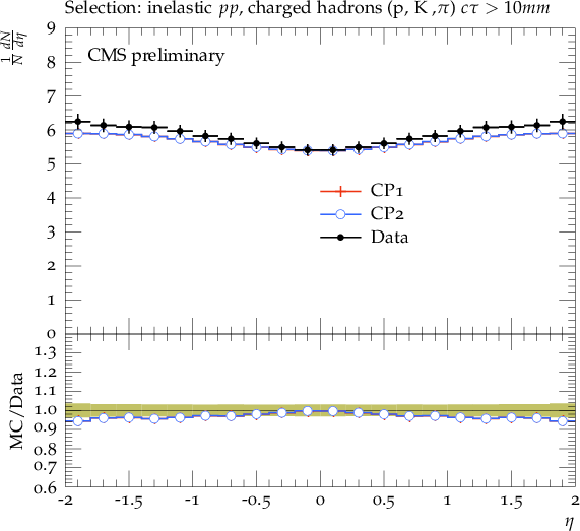
png pdf |
Figure 9-a:
CMS data at $\sqrt{s} = $ 13 TeV [19] on the pseudorapidity distribution of charged hadrons, measured with $ {p_{\mathrm {T}}} > $ 0 GeV in $|\eta | < $ 2 for an inclusive selection in inelastic proton-proton collisions. The data are compared with the CMS PYTHIA 8 LO-PDF tunes CP1 and CP2. The ratios of the theory and the data (MC/data) are also shown, where the shaded band indicates the total experimental uncertainty of the data. |

png pdf |
Figure 9-b:
CMS data at $\sqrt{s} = $ 13 TeV [19] on the pseudorapidity distribution of charged hadrons, measured with $ {p_{\mathrm {T}}} > $ 0 GeV in $|\eta | < $ 2 for an inclusive selection in inelastic proton-proton collisions. The data are compared with the CMS PYTHIA 8 NLO-PDF tune CP3 and the CMS PYTHIA 8 NNLO-PDF tunes CP4 and CP5. The ratios of the theory and the data (MC/data) are also shown, where the shaded band indicates the total experimental uncertainty of the data. |

png pdf |
Figure 10:
CMS data at $\sqrt{s} = $ 13 TeV [10] on the pseudorapidity distribution (${p_{\mathrm {T}}} > $ 0.5, $|\eta | < $ 2.4) for (left) the non-single diffraction (NSD) enhanced event selection and (right) the single-diffraction (SD) enhanced event selection of charged particles in inelastic proton-proton collisions. The data are compared with the CMS PYTHIA 8 LO-PDF tunes CP1 and CP2, the CMS PYTHIA 8 NLO-PDF tune CP3, and the CMS PYTHIA 8 NNLO-PDF tunes CP4 and CP5. The ratio of the theory and the data (MC/data) is also shown, where the shaded band indicates the total experimental uncertainty of the data. |

png pdf |
Figure 10-a:
CMS data at $\sqrt{s} = $ 13 TeV [10] on the pseudorapidity distribution (${p_{\mathrm {T}}} > $ 0.5, $|\eta | < $ 2.4) for the non-single diffraction (NSD) enhanced event selection of charged particles in inelastic proton-proton collisions. The data are compared with the CMS PYTHIA 8 LO-PDF tunes CP1 and CP2, the CMS PYTHIA 8 NLO-PDF tune CP3, and the CMS PYTHIA 8 NNLO-PDF tunes CP4 and CP5. The ratio of the theory and the data (MC/data) is also shown, where the shaded band indicates the total experimental uncertainty of the data. |

png pdf |
Figure 10-b:
CMS data at $\sqrt{s} = $ 13 TeV [10] on the pseudorapidity distribution (${p_{\mathrm {T}}} > $ 0.5, $|\eta | < $ 2.4) for the single-diffraction (SD) enhanced event selection of charged particles in inelastic proton-proton collisions. The data are compared with the CMS PYTHIA 8 LO-PDF tunes CP1 and CP2, the CMS PYTHIA 8 NLO-PDF tune CP3, and the CMS PYTHIA 8 NNLO-PDF tunes CP4 and CP5. The ratio of the theory and the data (MC/data) is also shown, where the shaded band indicates the total experimental uncertainty of the data. |

png pdf |
Figure 11:
CMS data at $\sqrt{s} = $ 13 TeV [12] on the transMIN charged-particle multiplicity (left) and $ {p_{\mathrm {T}}} $ sum (right) densities for particles with $ {p_{\mathrm {T}}} > $ 0.5 GeV in $|\eta |$ < 2.0, as defined by the leading charged-particle jet, as a function of the transverse momentum of the leading charged-particle jet, $ {p_{\mathrm {T}}} ^{\rm jet}$. The upper plots show the leading-order tunes and lower plots show the higher-order tunes. The ratio of the theory and the data (MC/data) is also shown, where the shaded band indicates the total experimental uncertainty of the data. |

png pdf |
Figure 11-a:
CMS data at $\sqrt{s} = $ 13 TeV [12] on the transMIN charged-particle multiplicity density for particles with $ {p_{\mathrm {T}}} > $ 0.5 GeV in $|\eta |$ < 2.0, as defined by the leading charged-particle jet, as a function of the transverse momentum of the leading charged-particle jet, $ {p_{\mathrm {T}}} ^{\rm jet}$. The upper plot shows the leading-order tunes and lower plot shows the higher-order tunes. The ratio of the theory and the data (MC/data) is also shown, where the shaded band indicates the total experimental uncertainty of the data. |
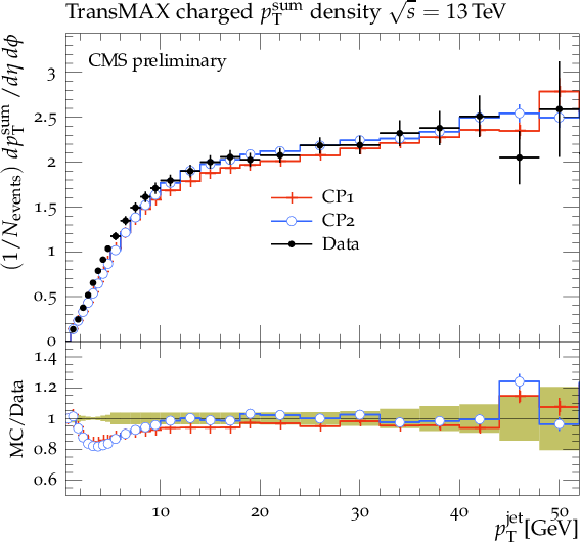
png pdf |
Figure 11-b:
CMS data at $\sqrt{s} = $ 13 TeV [12] on the $ {p_{\mathrm {T}}} $ sum density for particles with $ {p_{\mathrm {T}}} > $ 0.5 GeV in $|\eta |$ < 2.0, as defined by the leading charged-particle jet, as a function of the transverse momentum of the leading charged-particle jet, $ {p_{\mathrm {T}}} ^{\rm jet}$. The upper plot shows the leading-order tunes and lower plot shows the higher-order tunes. The ratio of the theory and the data (MC/data) is also shown, where the shaded band indicates the total experimental uncertainty of the data. |
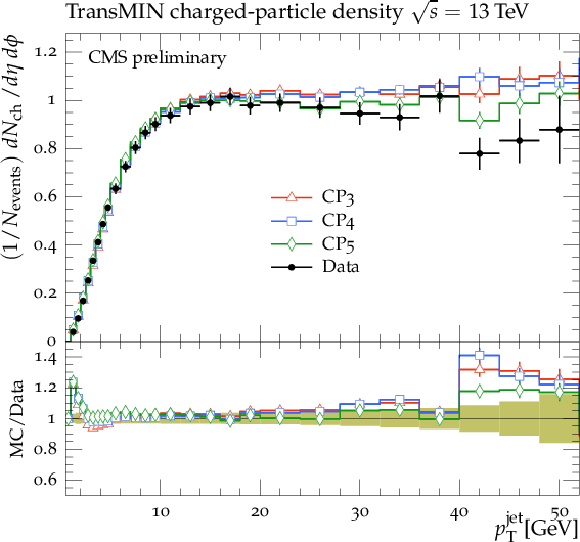
png pdf |
Figure 11-c:
CMS data at $\sqrt{s} = $ 13 TeV [12] on the transMIN charged-particle multiplicity (left) and $ {p_{\mathrm {T}}} $ sum (right) densities for particles with $ {p_{\mathrm {T}}} > $ 0.5 GeV in $|\eta |$ < 2.0, as defined by the leading charged-particle jet, as a function of the transverse momentum of the leading charged-particle jet, $ {p_{\mathrm {T}}} ^{\rm jet}$. The upper plots show the leading-order tunes and lower plots show the higher-order tunes. The ratio of the theory and the data (MC/data) is also shown, where the shaded band indicates the total experimental uncertainty of the data. |

png pdf |
Figure 11-d:
CMS data at $\sqrt{s} = $ 13 TeV [12] on the transMIN charged-particle multiplicity (left) and $ {p_{\mathrm {T}}} $ sum (right) densities for particles with $ {p_{\mathrm {T}}} > $ 0.5 GeV in $|\eta |$ < 2.0, as defined by the leading charged-particle jet, as a function of the transverse momentum of the leading charged-particle jet, $ {p_{\mathrm {T}}} ^{\rm jet}$. The upper plots show the leading-order tunes and lower plots show the higher-order tunes. The ratio of the theory and the data (MC/data) is also shown, where the shaded band indicates the total experimental uncertainty of the data. |

png pdf |
Figure 12:
CMS data at $\sqrt{s} = $ 13 TeV [12] on the energy flow measured in an inclusive selection as a function of pseudorapidity. The data are compared with (left) the CMS PYTHIA 8 LO-PDF tunes CP1 and CP2, and with (right) the CMS PYTHIA 8 NLO-PDF tune CP3 and the CMS PYTHIA 8 NNLO-PDF tunes CP4 and CP5. The ratio of the theory and the data (MC/data) is also shown, where the shaded band indicates the total experimental uncertainty of the data. |

png pdf |
Figure 12-a:
CMS data at $\sqrt{s} = $ 13 TeV [12] on the energy flow measured in an inclusive selection as a function of pseudorapidity. The data are compared with the CMS PYTHIA 8 LO-PDF tunes CP1 and CP2. The ratio of the theory and the data (MC/data) is also shown, where the shaded band indicates the total experimental uncertainty of the data. |

png pdf |
Figure 12-b:
CMS data at $\sqrt{s} = $ 13 TeV [12] on the energy flow measured in an inclusive selection as a function of pseudorapidity. The data are compared with the CMS PYTHIA 8 NLO-PDF tune CP3 and the CMS PYTHIA 8 NNLO-PDF tunes CP4 and CP5. The ratio of the theory and the data (MC/data) is also shown, where the shaded band indicates the total experimental uncertainty of the data. |

png pdf |
Figure 13:
CMS data at $\sqrt{s} = $ 13 TeV [34] on the total energy spectrum measured in the pseudorapidity interval $-6.6 < \eta < -5.2$. The data are compared with (left) the CMS PYTHIA 8 LO-PDF tunes CP1 and CP2, and with (right) the CMS PYTHIA 8 NLO-PDF tune CP3 and the CMS PYTHIA 8 NNLO-PDF tunes CP4 and CP5. The ratio of the theory and the data (MC/data) is also shown, where the shaded band indicates the total experimental uncertainty of the data. |

png pdf |
Figure 13-a:
CMS data at $\sqrt{s} = $ 13 TeV [34] on the total energy spectrum measured in the pseudorapidity interval $-6.6 < \eta < -5.2$. The data are compared with the CMS PYTHIA 8 LO-PDF tunes CP1 and CP2. The ratio of the theory and the data (MC/data) is also shown, where the shaded band indicates the total experimental uncertainty of the data. |

png pdf |
Figure 13-b:
CMS data at $\sqrt{s} = $ 13 TeV [34] on the total energy spectrum measured in the pseudorapidity interval $-6.6 < \eta < -5.2$. The data are compared with the CMS PYTHIA 8 NLO-PDF tune CP3 and the CMS PYTHIA 8 NNLO-PDF tunes CP4 and CP5. The ratio of the theory and the data (MC/data) is also shown, where the shaded band indicates the total experimental uncertainty of the data. |

png pdf |
Figure 14:
CMS data at $\sqrt{s} = $ 13 TeV [42] on the azimuthal angle difference $\Delta \phi _{1,2}$ between the leading two jets with $|\eta | < $ 2.4 in dijet events with leading-jet transverse momentum in the range (a) 200 $ < {p_{\mathrm {T}}} < $ 300 GeV and (b) 300 $ < {p_{\mathrm {T}}} < $ 400 GeV. The jets are reconstructed using the anti-$ {k_{\mathrm {T}}} $ algorithm [43,44] with cone size equal to 0.4. The data are compared to predictions of the NLO dijet matrix element calculation from POWHEG, interfaced to the PYTHIA 8 tunes CUETP8M1, CP2, CP4, and CP5. The ratios of the theory and the data (MC/data) are also shown, where the shaded band indicates the total experimental uncertainty of the data. |

png pdf |
Figure 14-a:
CMS data at $\sqrt{s} = $ 13 TeV [42] on the azimuthal angle difference $\Delta \phi _{1,2}$ between the leading two jets with $|\eta | < $ 2.4 in dijet events with leading-jet transverse momentum in the range 200 $ < {p_{\mathrm {T}}} < $ 300 GeV. The jets are reconstructed using the anti-$ {k_{\mathrm {T}}} $ algorithm [43,44] with cone size equal to 0.4. The data are compared to predictions of the NLO dijet matrix element calculation from POWHEG, interfaced to the PYTHIA 8 tunes CUETP8M1, CP2, CP4, and CP5. The ratios of the theory and the data (MC/data) are also shown, where the shaded band indicates the total experimental uncertainty of the data. |

png pdf |
Figure 14-b:
CMS data at $\sqrt{s} = $ 13 TeV [42] on the azimuthal angle difference $\Delta \phi _{1,2}$ between the leading two jets with $|\eta | < $ 2.4 in dijet events with leading-jet transverse momentum in the range 300 $ < {p_{\mathrm {T}}} < $ 400 GeV. The jets are reconstructed using the anti-$ {k_{\mathrm {T}}} $ algorithm [43,44] with cone size equal to 0.4. The data are compared to predictions of the NLO dijet matrix element calculation from POWHEG, interfaced to the PYTHIA 8 tunes CUETP8M1, CP2, CP4, and CP5. The ratios of the theory and the data (MC/data) are also shown, where the shaded band indicates the total experimental uncertainty of the data. |

png pdf |
Figure 15:
CMS data at $\sqrt{s} = $ 7 TeV [46,47] on the correlation observable $\Delta S$ measured in 4j (left) and 2b2j (right) production, compared to predictions of PYTHIA 8 tunes CUETP8M1, CP2, CP4, and CP5. The ratios of the theory and the data (MC/data) are also shown, where the shaded band indicates the total experimental uncertainty of the data. |

png pdf |
Figure 15-a:
CMS data at $\sqrt{s} = $ 7 TeV [46,47] on the correlation observable $\Delta S$ measured in 4j production, compared to predictions of PYTHIA 8 tunes CUETP8M1, CP2, CP4, and CP5. The ratios of the theory and the data (MC/data) are also shown, where the shaded band indicates the total experimental uncertainty of the data. |

png pdf |
Figure 15-b:
CMS data at $\sqrt{s} = $ 7 TeV [46,47] on the correlation observable $\Delta S$ measured in 2b2j production, compared to predictions of PYTHIA 8 tunes CUETP8M1, CP2, CP4, and CP5. The ratios of the theory and the data (MC/data) are also shown, where the shaded band indicates the total experimental uncertainty of the data. |

png pdf |
Figure 16:
CMS data at $\sqrt{s} = $ 13 TeV [52] on the normalized $\rm {t}\overline {\rm t}$ right cross section in the lepton+jets channel, as a function of the transverse momentum of the top quark for leptonically decaying top quarks ($t_\ell $) (upper), the invariant mass of the top quark pair system, $M({{\mathrm {t}\overline {\mathrm {t}}}})$ (middle), and in bins of number of additional jets (lower). The data are compared to the predictions of POWHEG (left) and MG5_aMC [FxFx] (right). In both cases, the parton-shower simulation is done with the PYTHIA 8 tunes CUETP8M1, CP2, CP4, or CP5. The ratios of the theory and the data (MC/data) are also shown, where the shaded band indicates the total experimental uncertainty of the data. |

png pdf |
Figure 16-a:
CMS data at $\sqrt{s} = $ 13 TeV [52] on the normalized $\rm {t}\overline {\rm t}$ right cross section in the lepton+jets channel, as a function of the transverse momentum of the top quark for leptonically decaying top quarks ($t_\ell $). The data are compared to the predictions of POWHEG. The parton-shower simulation is done with the PYTHIA 8 tunes CUETP8M1, CP2, CP4, or CP5. The ratios of the theory and the data (MC/data) are also shown, where the shaded band indicates the total experimental uncertainty of the data. |
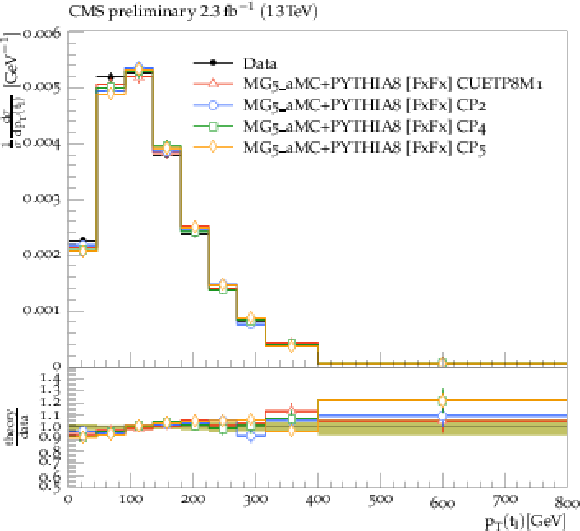
png pdf |
Figure 16-b:
CMS data at $\sqrt{s} = $ 13 TeV [52] on the normalized $\rm {t}\overline {\rm t}$ right cross section in the lepton+jets channel, as a function of the transverse momentum of the top quark for leptonically decaying top quarks ($t_\ell $). The data are compared to the predictions of MG5_aMC [FxFx]. The parton-shower simulation is done with the PYTHIA 8 tunes CUETP8M1, CP2, CP4, or CP5. The ratios of the theory and the data (MC/data) are also shown, where the shaded band indicates the total experimental uncertainty of the data. |

png pdf |
Figure 16-c:
CMS data at $\sqrt{s} = $ 13 TeV [52] on the normalized $\rm {t}\overline {\rm t}$ right cross section in the lepton+jets channel, as a function of the invariant mass of the top quark pair system, $M({{\mathrm {t}\overline {\mathrm {t}}}})$. The data are compared to the predictions of POWHEG. The parton-shower simulation is done with the PYTHIA 8 tunes CUETP8M1, CP2, CP4, or CP5. The ratios of the theory and the data (MC/data) are also shown, where the shaded band indicates the total experimental uncertainty of the data. |

png pdf |
Figure 16-d:
CMS data at $\sqrt{s} = $ 13 TeV [52] on the normalized $\rm {t}\overline {\rm t}$ right cross section in the lepton+jets channel, as a function of the invariant mass of the top quark pair system, $M({{\mathrm {t}\overline {\mathrm {t}}}})$. The data are compared to the predictions of MG5_aMC [FxFx]. The parton-shower simulation is done with the PYTHIA 8 tunes CUETP8M1, CP2, CP4, or CP5. The ratios of the theory and the data (MC/data) are also shown, where the shaded band indicates the total experimental uncertainty of the data. |

png pdf |
Figure 16-e:
CMS data at $\sqrt{s} = $ 13 TeV [52] on the normalized $\rm {t}\overline {\rm t}$ right cross section in the lepton+jets channel, in bins of number of additional jets. The data are compared to the predictions of POWHEG. The parton-shower simulation is done with the PYTHIA 8 tunes CUETP8M1, CP2, CP4, or CP5. The ratios of the theory and the data (MC/data) are also shown, where the shaded band indicates the total experimental uncertainty of the data. |

png pdf |
Figure 16-f:
CMS data at $\sqrt{s} = $ 13 TeV [52] on the normalized $\rm {t}\overline {\rm t}$ right cross section in the lepton+jets channel, in bins of number of additional jets. The data are compared to the predictions of MG5_aMC [FxFx]. The parton-shower simulation is done with the PYTHIA 8 tunes CUETP8M1, CP2, CP4, or CP5. The ratios of the theory and the data (MC/data) are also shown, where the shaded band indicates the total experimental uncertainty of the data. |

png pdf |
Figure 17:
The charged-particle multiplicity (left) and $p_{\rm T}^{\rm sum}$ (right) in the toward (upper), transverse (middle), and away (lower) regions measured as a function of the Z boson $ {p_{\mathrm {T}}} $ in Drell-Yan events at $\sqrt{s} = $ 13 TeV [53], and compared to the predictions obtained by an inclusive NLO matrix element calculated by MG5_aMC, interfaced to the UE simulation of PYTHIA 8 with the CUETP8M1, CP2, CP4, and CP5 tunes. The ratios of the theory and the data (MC/data) are also shown, where the shaded band indicates the total experimental uncertainty of the data. |

png pdf |
Figure 17-a:
The charged-particle in the toward region measured as a function of the Z boson $ {p_{\mathrm {T}}} $ in Drell-Yan events at $\sqrt{s} = $ 13 TeV [53], and compared to the predictions obtained by an inclusive NLO matrix element calculated by MG5_aMC, interfaced to the UE simulation of PYTHIA 8 with the CUETP8M1, CP2, CP4, and CP5 tunes. The ratios of the theory and the data (MC/data) are also shown, where the shaded band indicates the total experimental uncertainty of the data. |

png pdf |
Figure 17-b:
The $p_{\rm T}^{\rm sum}$ in the toward region measured as a function of the Z boson $ {p_{\mathrm {T}}} $ in Drell-Yan events at $\sqrt{s} = $ 13 TeV [53], and compared to the predictions obtained by an inclusive NLO matrix element calculated by MG5_aMC, interfaced to the UE simulation of PYTHIA 8 with the CUETP8M1, CP2, CP4, and CP5 tunes. The ratios of the theory and the data (MC/data) are also shown, where the shaded band indicates the total experimental uncertainty of the data. |

png pdf |
Figure 17-c:
The charged-particle multiplicity in the transverse region measured as a function of the Z boson $ {p_{\mathrm {T}}} $ in Drell-Yan events at $\sqrt{s} = $ 13 TeV [53], and compared to the predictions obtained by an inclusive NLO matrix element calculated by MG5_aMC, interfaced to the UE simulation of PYTHIA 8 with the CUETP8M1, CP2, CP4, and CP5 tunes. The ratios of the theory and the data (MC/data) are also shown, where the shaded band indicates the total experimental uncertainty of the data. |

png pdf |
Figure 17-d:
The $p_{\rm T}^{\rm sum}$ in the transverse region measured as a function of the Z boson $ {p_{\mathrm {T}}} $ in Drell-Yan events at $\sqrt{s} = $ 13 TeV [53], and compared to the predictions obtained by an inclusive NLO matrix element calculated by MG5_aMC, interfaced to the UE simulation of PYTHIA 8 with the CUETP8M1, CP2, CP4, and CP5 tunes. The ratios of the theory and the data (MC/data) are also shown, where the shaded band indicates the total experimental uncertainty of the data. |
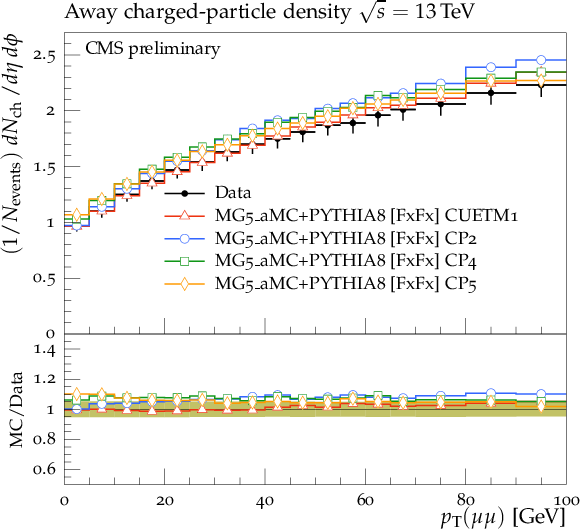
png pdf |
Figure 17-e:
The charged-particle multiplicity in the away region measured as a function of the Z boson $ {p_{\mathrm {T}}} $ in Drell-Yan events at $\sqrt{s} = $ 13 TeV [53], and compared to the predictions obtained by an inclusive NLO matrix element calculated by MG5_aMC, interfaced to the UE simulation of PYTHIA 8 with the CUETP8M1, CP2, CP4, and CP5 tunes. The ratios of the theory and the data (MC/data) are also shown, where the shaded band indicates the total experimental uncertainty of the data. |

png pdf |
Figure 17-f:
The $p_{\rm T}^{\rm sum}$ in the away region measured as a function of the Z boson $ {p_{\mathrm {T}}} $ in Drell-Yan events at $\sqrt{s} = $ 13 TeV [53], and compared to the predictions obtained by an inclusive NLO matrix element calculated by MG5_aMC, interfaced to the UE simulation of PYTHIA 8 with the CUETP8M1, CP2, CP4, and CP5 tunes. The ratios of the theory and the data (MC/data) are also shown, where the shaded band indicates the total experimental uncertainty of the data. |

png pdf |
Figure 18:
Comparison with the measurement [54] of the exclusive jet multiplicity in Z+jets (upper) and W+jets (lower) events predicted by MG5_aMC + PYTHIA 8 with $k_{\text {T}}$-MLM matching (left) and FxFx merging (right) for the different tunes. The ratios of the theory and the data (MC/data) are also shown, where the shaded band indicates the total experimental uncertainty of the data. |
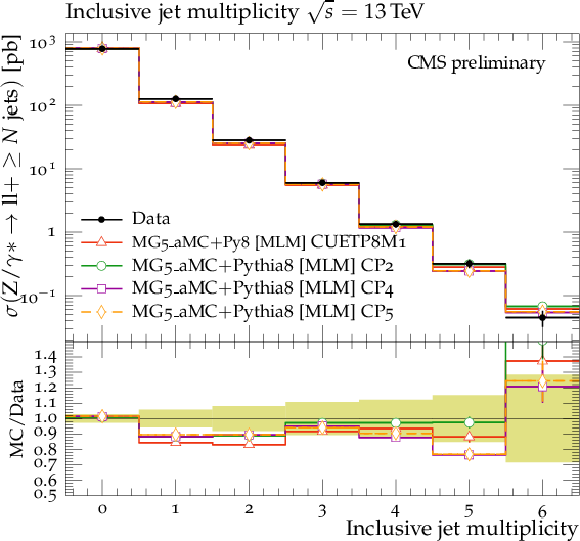
png pdf |
Figure 18-a:
Comparison with the measurement [54] of the exclusive jet multiplicity in Z+jets events predicted by MG5_aMC + PYTHIA 8 with $k_{\text {T}}$-MLM matching for the different tunes. The ratios of the theory and the data (MC/data) are also shown, where the shaded band indicates the total experimental uncertainty of the data. |

png pdf |
Figure 18-b:
Comparison with the measurement [54] of the exclusive jet multiplicity in Z+jets events predicted by MG5_aMC + PYTHIA 8 with FxFx merging for the different tunes. The ratios of the theory and the data (MC/data) are also shown, where the shaded band indicates the total experimental uncertainty of the data. |

png pdf |
Figure 18-c:
Comparison with the measurement [54] of the exclusive jet multiplicity in W+jets events predicted by MG5_aMC + PYTHIA 8 with $k_{\text {T}}$-MLM matching for the different tunes. The ratios of the theory and the data (MC/data) are also shown, where the shaded band indicates the total experimental uncertainty of the data. |

png pdf |
Figure 18-d:
Comparison with the measurement [54] of the exclusive jet multiplicity in W+jets events predicted by MG5_aMC + PYTHIA 8 with FxFx merging for the different tunes. The ratios of the theory and the data (MC/data) are also shown, where the shaded band indicates the total experimental uncertainty of the data. |
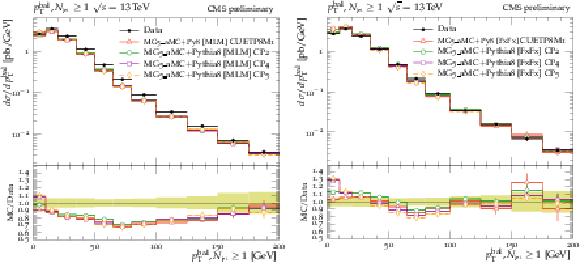
png pdf |
Figure 19:
Comparison with the measurement [54] of the $ {p_{\mathrm {T}}} $ balance predicted by MG5_aMC + PYTHIA 8 with $k_{\text {T}}$-MLM matching (left) and FxFx merging (right) for the different tunes for events with at least one jet. The ratios of the theory and the data (MC/data) are also shown, where the shaded band indicates the total experimental uncertainty of the data. |
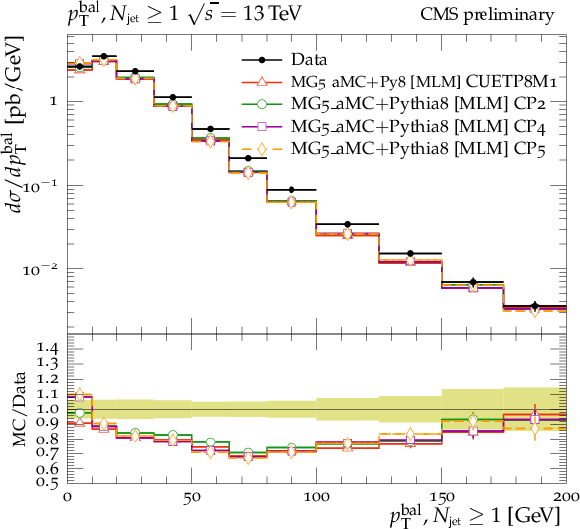
png pdf |
Figure 19-a:
Comparison with the measurement [54] of the $ {p_{\mathrm {T}}} $ balance predicted by MG5_aMC + PYTHIA 8 with $k_{\text {T}}$-MLM matching for the different tunes for events with at least one jet. The ratios of the theory and the data (MC/data) are also shown, where the shaded band indicates the total experimental uncertainty of the data. |

png pdf |
Figure 19-b:
Comparison with the measurement [54] of the $ {p_{\mathrm {T}}} $ balance predicted by MG5_aMC + PYTHIA 8 with FxFx merging for the different tunes for events with at least one jet. The ratios of the theory and the data (MC/data) are also shown, where the shaded band indicates the total experimental uncertainty of the data. |

png pdf |
Figure 20:
Comparison with the measurement [54] of the $ {p_{\mathrm {T}}} $ (Z) predicted by MG5_aMC + PYTHIA 8 with $k_{\text {T}}$-MLM matching (left) and FxFx merging (right) for the different tunes. The ratios of the theory and the data (MC/data) are also shown, where the shaded band indicates the total experimental uncertainty of the data. |

png pdf |
Figure 20-a:
Comparison with the measurement [54] of the $ {p_{\mathrm {T}}} $ (Z) predicted by MG5_aMC + PYTHIA 8 with $k_{\text {T}}$-MLM matching for the different tunes. The ratios of the theory and the data (MC/data) are also shown, where the shaded band indicates the total experimental uncertainty of the data. |
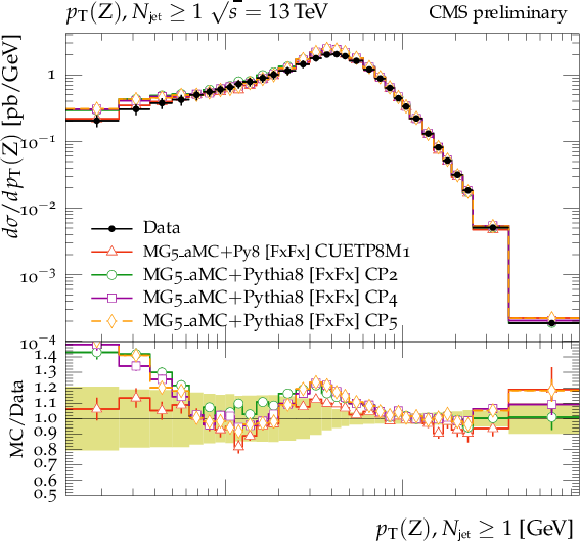
png pdf |
Figure 20-b:
Comparison with the measurement [54] of the $ {p_{\mathrm {T}}} $ (Z) predicted by MG5_aMC + PYTHIA 8 with FxFx merging for the different tunes. The ratios of the theory and the data (MC/data) are also shown, where the shaded band indicates the total experimental uncertainty of the data. |

png pdf |
Figure 21:
Charged-particle (left) and charged $p_{\rm T}^{\rm sum}$ (right) density in the transMIN region at $\sqrt {s} = $ 13 TeV. The gray band represents the total UE uncertainty for the tune CP5. The variations allowed by the CP5 tune when $\alpha _{\rm S}^{\rm ISR}(M_{\mathrm{Z}})$ and $\alpha _{\rm S}^{\rm FSR}(M_{\mathrm{Z}})$ are left free in the fit. |

png pdf |
Figure 21-a:
Charged-particle density in the transMIN region at $\sqrt {s} = $ 13 TeV. The gray band represents the total UE uncertainty for the tune CP5. The variations allowed by the CP5 tune when $\alpha _{\rm S}^{\rm ISR}(M_{\mathrm{Z}})$ and $\alpha _{\rm S}^{\rm FSR}(M_{\mathrm{Z}})$ are left free in the fit. |

png pdf |
Figure 21-b:
Charged $p_{\rm T}^{\rm sum}$ density in the transMIN region at $\sqrt {s} = $ 13 TeV. The gray band represents the total UE uncertainty for the tune CP5. The variations allowed by the CP5 tune when $\alpha _{\rm S}^{\rm ISR}(M_{\mathrm{Z}})$ and $\alpha _{\rm S}^{\rm FSR}(M_{\mathrm{Z}})$ are left free in the fit. |
| Tables | |

png pdf |
Table 1:
Parameters in the PYTHIA 8 MC event generator that, together with some chosen PDF, determine the energy dependence of MPI, the overlap matter distribution function, and the amount of simulated color reconnection. The parameter ranges used for the fits are also listed for the tunes. |
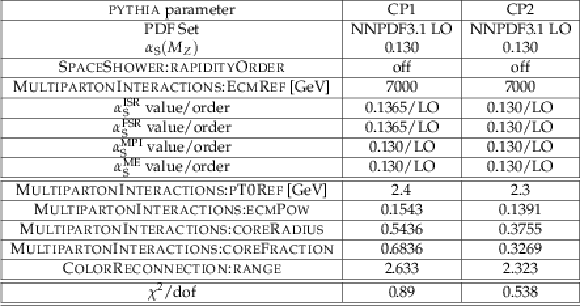
png pdf |
Table 2:
CMS PYTHIA 8 LO-PDF tunes CP1 and CP2. Both the values at $Q = M_{\mathrm{Z}}$ and the order of running with $Q^2$ of the strong coupling $\alpha _{\rm S}(M_{\mathrm{Z}})$ are listed. In all tunes, we use the Schuler-Sjostrand diffraction model [32]. The tunes CP1 and CP2 are obtained including the simulation of central-diffractive processes. |
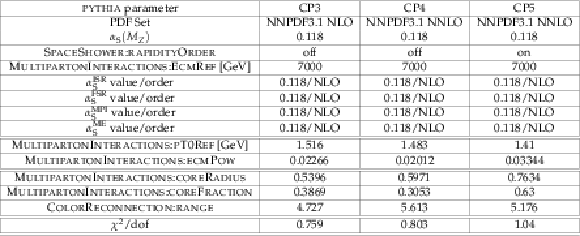
png pdf |
Table 3:
CMS PYTHIA 8 NLO-PDF tune CP3 and NNLO-PDF tunes CP4 and CP5. Both the values at $Q = M_{\mathrm{Z}}$ and the order of running with $Q^2$ of the strong coupling $\alpha _{\rm S}$ are listed. In these tunes, we use the Schuler-Sjostrand diffraction model [32] and also include the simulation of central-diffraction processes. |

png pdf |
Table 4:
Values of $\sigma _{\rm {eff}}$ at $\sqrt {s} = $ 7 TeV published by the CMS Collaboration for the four-jet final states, obtained by fitting predictions of the PYTHIA 8 MC event generator to DPS-sensitive measured observables. |

png pdf |
Table 5:
Values of $\sigma _{\rm {eff}}$ at $\sqrt {s} = $ 7 and 13 TeV obtained with the new CMS UE tunes. |

png pdf |
Table 6:
Parameters of the "up-'' and "down-''variation eigentunes for the PYTHIA 8 CP5 tune. |

png pdf |
Table 7:
"Up'' and "Down'' ISR and FSR variations for CP5 when $\alpha _{\rm S}^{\rm ISR}(M_{\mathrm{Z}})$ or $\alpha _{\rm S}^{\rm FSR}(M_{\mathrm{Z}})$ is treated as a free parameter. |
| Summary |
|
A new set of tunes for the underlying event simulation in the PYTHIA 8 event generator has been obtained by fitting various measurements sensitive to soft and semi-hard multiparton interactions at different collision energies. To derive these tunes, we use the LO, NLO, and NNLO versions of the NNPDF3.1 set for the simulation of the underlying event components. We tested tunes for which the values of the strong coupling ($\alpha_{\rm S}(M_{\mathrm{Z}})$) used for the simulation of hard scattering, initial- and final-state radiation and multiparton interactions are chosen consistently with the order of the used PDF. With the LO NNPDF3.1 set, $\alpha_{\rm S}(M_{\mathrm{Z}})$ is fixed to 0.130, while for the NLO and NNLO NNPDF3.1 sets, the value of 0.118 is used for $\alpha_{\rm S}(M_{\mathrm{Z}})$. In general, the mixture of contributions from multiparton interactions and parton shower emissions is crucial to give a good description of variables measured in soft collision events. Independently of the used PDF, predictions from the new tunes are able to reproduce very well the UE measurements at $\sqrt{s}$ = 1.96 and 7 TeV, and a significant improvement in the description of UE measurements at $\sqrt{s} = $ 13 TeV is observed with respect to predictions from old tunes, extracted with data at lower collision energies. For the first time, we showed that predictions obtained with tunes based on higher-order PDF sets are able to give a reliable description of MB and UE measurements, with a similar level of agreement as predictions from tunes using LO PDF sets. Predictions of the new tunes agree well with minimum-bias observables measured at pseudorapidities in the central ($|\eta| < $ 2.4) and forward (3.2 $ < |\eta| < $ 4.7) regions. We showed that the new CMS tunes simultaneously describe the number of charged particles produced in diffractive processes and inelastic collisions. New CMS tunes or the CUETP8M1 tune can only poorly describe the very forward region ($-6.6 < \eta < -5.2$) data. Measurements sensitive to double-parton scattering contributions are reproduced better by predictions using the LO PDF set in the UE simulation and without rapidity ordering of the initial-state shower. The UE simulation provided by the new tunes can be interfaced to higher-order and multileg matrix-element generators, such as POWHEG and MG5_aMC, without worsening the good description of UE observables. Such predictions also reproduce well observables measured in multijet final states, and Drell-Yan and top quark production processes. The central values of the normalized $\mathrm{t\bar{t}}$ cross sections in bins of the number of additional jets predicted by POWHEG + PYTHIA 8 overshoots the data when a high value of $\alpha_{\rm S}^{\rm ISR}(M_{\mathrm{Z}}) > $ 0.130 is used (CP1 and CP2 tunes). It is also observed that even when $\alpha_{\rm S}^{\rm ISR}(M_{\mathrm{Z}})= $ 0.118 is used, the CP4 tune overshoots the data at high jet multiplicities. This is cured by the rapidity ordering of the initial-state shower (CP5 tune). Measurements of azimuthal dijet correlations are also better described when a value of $\alpha_{\rm S}^{\rm ISR}(M_{\mathrm{Z}})= $ 0.118 is used in predictions obtained with POWHEG matched to PYTHIA 8. All of the new CMS tunes come with their eigentunes, which can be used to determine the uncertainties associated with the theoretical predictions. We have shown that predictions using the new tunes based on PDFs determined at LO, NLO, and NNLO agree reasonably well with the measurements, and that the new tunes can be also applied to LO and NLO calculations matched to parton showers, MPI, and hadronization. |
| References | ||||
| 1 | T. Sjostrand et al. | An introduction to $ PYTHIA $ 8.2 | CPC 191 (2015) 159 | 1410.3012 |
| 2 | M. Bahr et al. | Herwig++ Physics and Manual | Eur.Phys.J. C 58 (2008) 639 | 0803.0883 |
| 3 | J. Bellm et al. | Herwig 7.0/Herwig++ 3.0 release note | EPJC 76 (2016) 196 | 1512.01178 |
| 4 | T. Gleisberg et al. | Event generation with SHERPA 1.1 | JHEP 02 (2009) 007 | 0811.4622 |
| 5 | CMS Collaboration | Event generator tunes obtained from underlying event and multiparton scattering measurements | EPJC 76 (2016) 155 | CMS-GEN-14-001 1512.00815 |
| 6 | P. Skands, S. Carrazza, and J. Rojo | Tuning pythia 8.1: the monash 2013 tune | EPJC 74 (2014) 3024 | 1404.5630 |
| 7 | S. Carrazza, S. Forte, and J. Rojo | Parton distributions and event generators | in Proceedings, 43rd International Symposium on Multiparticle Dynamics (ISMD 13) 2013 | 1311.5887 |
| 8 | CDF Collaboration | Study of the energy dependence of the underlying event in proton-antiproton collisions | PRD 92 (2015) 092009 | 1508.05340 |
| 9 | CMS Collaboration | Measurement of the underlying event activity at the LHC at 7 TeV and comparison with 0.9 TeV | CDS | |
| 10 | CMS Collaboration | Measurement of pseudorapidity distributions of charged particles in proton-proton collisions at $ \sqrt{s} = $ 13 TeV by the cms experiment | CMS-PAS-FSQ-15-008 | CMS-PAS-FSQ-15-008 |
| 11 | T. Sjostrand, S. Mrenna, and P. Skands | $ PYTHIA $ 6.4 physics and manual | JHEP 05 (2006) 026 | hep-ph/0603175 |
| 12 | CMS Collaboration | Underlying Event Measurements with Leading Particles and Jets in pp collisions at $ \sqrt{s} = $ 13 TeV | CMS-PAS-FSQ-15-007 | CMS-PAS-FSQ-15-007 |
| 13 | L. A. Harland-Lang, A. D. Martin, P. Motylinski, and R. S. Thorne | Parton distributions in the LHC era: MMHT 2014 PDFs | EPJC 75 (2015) 204 | 1412.3989 |
| 14 | S. Gieseke, F. Loshaj, and P. Kirchgae\sser | Soft and diffractive scattering with the cluster model in herwig | EPJC 77 (2017) 156 | 1612.04701 |
| 15 | CMS Collaboration | Measurement of $ \mathrm {t}\overline{\mathrm {t}} $ production with additional jet activity, including $ \mathrm {b} $ quark jets, in the dilepton decay channel using pp collisions at $ \sqrt{s} = $ 8 TeV | EPJC 76 (2016), no. 7 | CMS-TOP-12-041 1510.03072 |
| 16 | CMS Collaboration | Measurement of particle level differential $ t\overline{t} $ cross sections in the dilepton channel at $ \sqrt{s} = $ 13 TeV | CMS-PAS-TOP-16-007 | CMS-PAS-TOP-16-007 |
| 17 | CMS Collaboration | Measurement of $\rm t \bar t$ production cross section at 13 TeV in the all-jets final state'', | CMS-PAS-TOP-16-013 | CMS-PAS-TOP-16-013 |
| 18 | ATLAS Collaboration | Atlas $ PYTHIA8 $ tunes to 7 TeV data | ATLAS Note ATL-PHYS-PUB-2014-021 | |
| 19 | CMS Collaboration | Pseudorapidity distribution of charged hadrons in proton-proton collisions at $ \sqrt{s} = $ 13 tev | PLB 751 (2015) 143 | CMS-FSQ-15-001 1507.05915 |
| 20 | ATLAS Collaboration | Measurement of charged-particle distributions sensitive to the underlying event in $ \sqrt{s}= $ 13 TeV proton-proton collisions with the ATLAS detector at the LHC | JHEP 03 (2017) 157 | 1701.05390 |
| 21 | P. Gunnellini, H. Jung, and R. Maharucksit | Investigation of the energy dependence of the $ p_{\text {t0}} $ parameter in the pythia 8 monte carlo event generator | EPJC 78 (2018) 521 | 1801.02536 |
| 22 | B. Cooper et al. | Importance of a consistent choice of $ \alpha_s $ in the matching of AlpGen and Pythia | EPJC 72 (2012) 2078 | 1109.5295 |
| 23 | NNPDF Collaboration | Parton distributions from high-precision collider data | EPJC 77 (2017) 663 | 1706.00428 |
| 24 | S. Alioli, P. Nason, C. Oleari, and E. Re | A general framework for implementing NLO calculations in shower Monte Carlo programs: the POWHEG BOX | JHEP 06 (2010) 043 | 1002.2581 |
| 25 | J. Alwall et al. | The automated computation of tree-level and next-to-leading order differential cross sections, and their matching to parton shower simulations | JHEP 07 (2014) 079 | 1405.0301 |
| 26 | R. Frederix and S. Frixione | Merging meets matching in MC@NLO | JHEP 12 (2012) 061 | 1209.6215 |
| 27 | S. Frixione, P. Nason, and C. Oleari | Matching NLO QCD computations with Parton Shower simulations: the POWHEG method | JHEP 11 (2007) 070 | 0709.2092 |
| 28 | J. Alwall et al. | Comparative study of various algorithms for the merging of parton showers and matrix elements in hadronic collisions | EPJC 53 (2008) 473 | 0706.2569 |
| 29 | T. Sjostrand and P. Z. Skands | Multiple interactions and the structure of beam remnants | JHEP 03 (2004) 053 | hep-ph/0402078 |
| 30 | A. Buckley, J. Butterworth, D. Grellscheid et al. | Rivet user manual | CPC 184 (2013) 2803 | 1003.0694 |
| 31 | A. Buckley et al. | Systematic event generator tuning for the lhc | EPJC 65 (2010) 331 | 0907.2973 |
| 32 | G. A. Schuler and T. Sjostrand | Hadronic diffractive cross-sections and the rise of the total cross-section | PRD 49 (1994) 2257 | |
| 33 | CMS Collaboration | Measurement of the pseudorapidity dependence of the energy and transverse energy density in pp collisions at $ \sqrt{s}= $ 13 TeV with cms | CMS-PAS-FSQ-15-006 | CMS-PAS-FSQ-15-006 |
| 34 | CMS Collaboration | Measurement of the inclusive energy spectrum in the very forward direction in proton-proton collisions at $ \sqrt{s}= $ 13 TeV | JHEP 08 (2017) 046 | CMS-FSQ-16-002 1701.08695 |
| 35 | CMS Collaboration | Measurement of the inelastic proton-proton cross section at $ \sqrt{s}= $ 13 TeV | CMS-PAS-FSQ-15-005 | CMS-PAS-FSQ-15-005 |
| 36 | A. Donnachie and P. V. Landshoff | Elastic Scattering and Diffraction Dissociation | NPB 244 (1984) 322, .[,813(1984)] | |
| 37 | R. Ciesielski and K. Goulianos | Mbr Monte Carlo simulation in $ PYTHIA8 $ | PoS ICHEP2012 (2013) 301 | 1205.1446 |
| 38 | S. Alioli et al. | Jet pair production in powheg | JHEP 04 (2011) 081 | 1012.3380 |
| 39 | CMS Collaboration | Determination of jet energy calibration and transverse momentum resolution in CMS | Journal of Instrumentation 6 (2011) P11002 | |
| 40 | CMS Collaboration | Jet energy scale and resolution in the CMS experiment in pp collisions at 8 TeV | JINST 12 (2017), no. 02, P02014 | CMS-JME-13-004 1607.03663 |
| 41 | CMS Collaboration | Measurement of the double-differential inclusive jet cross section in proton-proton collisions at $ \sqrt{s} = $ 13 TeV | EPJC 76 (2016), no. 8, 451 | CMS-SMP-15-007 1605.04436 |
| 42 | CMS Collaboration | Azimuthal correlations for inclusive 2-jet, 3-jet, and 4-jet events in pp collisions at $ \sqrt{s}= $ 13 TeV | CMS-SMP-16-014 1712.05471 |
|
| 43 | M. Cacciari, G. P. Salam, and G. Soyez | The anti-$ k_t $ jet clustering algorithm | JHEP 04 (2008) 063 | 0802.1189 |
| 44 | M. Cacciari, G. P. Salam, and G. Soyez | FastJet user manual | EPJC 72 (2012) 1896 | 1111.6097 |
| 45 | D0 Collaboration | Measurement of Dijet Azimuthal Decorrelations at Central Rapidities in $ p\overline{p} $ Collisions at $ \sqrt{s}= $ 1.96 TeV | PRL 94 (Jun, 2005) 221801 | |
| 46 | CMS Collaboration | Measurement of four-jet production in proton-proton collisions at $ \sqrt{s}= $ 7 TeV | PRD 89 (2014), no. 9, 092010 | CMS-FSQ-12-013 1312.6440 |
| 47 | CMS Collaboration | Studies of inclusive four-jet production with two b tagged jets in proton-proton collisions at 7 TeV | PRD 94 (2016), no. 11, 112005 | CMS-FSQ-13-010 1609.03489 |
| 48 | B. Humpert and R. Odorico | Multi-parton scattering and qcd radiation as sources of four-jet events | Physics Letters B 154 (1985), no. 2, 211 -- 214 | |
| 49 | M. Mangano | Four jet production at the tevatron collider | Zeitschrift f\"ur Physik C Particles and Fields 42 (1989), no. 2 | |
| 50 | T. Sjostrand and M. van Zijl | A Multiple Interaction Model for the Event Structure in Hadron Collisions | PRD 36 (1987) 2019 | |
| 51 | P. Gunnellini | Study of double parton scattering using four-jet scenarios in proton-proton collisions at $ \sqrt{s} = $ 7 TeV with the CMS experiment at the Large Hadron Collider | PhD thesis, U. Hamburg, Dept. Phys. | |
| 52 | CMS Collaboration | Measurement of differential cross sections for top quark pair production using the lepton+jets final state in proton-proton collisions at 13 TeV | PRD 95 (2017) 092001 | CMS-TOP-16-008 1610.04191 |
| 53 | CMS Collaboration | Measurement of the underlying event activity in inclusive Z boson production in proton-proton collisions at $ \sqrt{s}= $ 13 TeV | JHEP 07 (2018) 032 | CMS-FSQ-16-008 1711.04299 |
| 54 | CMS Collaboration | Measurement of the differential cross section of z boson production in association with jets in proton-proton collisions at $ \sqrt{s} = $ 13 TeV | CMS-PAS-SMP-15-010 | CMS-PAS-SMP-15-010 |
| 55 | CMS Collaboration | Measurement of the differential cross section for the production of a w ($ \rightarrow \mu \nu $) boson in association with jets at $ \sqrt{s} = $ 13 TeV | CMS-PAS-SMP-16-005 | CMS-PAS-SMP-16-005 |

|
Compact Muon Solenoid LHC, CERN |

|

|

|

|

|

|